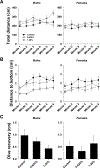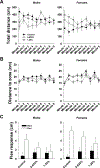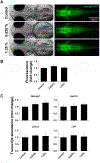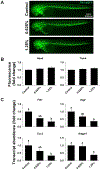Neurobehavioral effects of 1,2-propanediol in zebrafish (Danio rerio)
- PMID: 29432853
- PMCID: PMC7008519
- DOI: 10.1016/j.neuro.2018.02.007
Neurobehavioral effects of 1,2-propanediol in zebrafish (Danio rerio)
Abstract
The use of electronic cigarettes (e-cigarettes) is increasing despite insufficient information concerning their long-term effects, including the effects of maternal e-cigarette use on pre- and postnatal development. Our previous study demonstrated that developmental exposure to 1,2-propanediol (a principal component of e-cigarette liquid) affected early development of zebrafish, causing reduced growth, deformities, and hyperactive swimming behavior in larvae. The current study extends assessment of the developmental toxicity of 1,2-propanediol by examining additional long-term behavioral effects. We demonstrate that embryonic/larval exposure of zebrafish to 1,2-propanediol (0.625% or 1.25%) not only affected behavioral parameters in the larvae, but also caused persisting behavioral effects in adults after early developmental exposure. Additional parameters, including neural and vascular development in larvae, stress response in adults, and concentration of neurotransmitters dopamine and serotonin in adult brain were examined, in order to explain the behavioral differences. These additional assessments did not find 1,2-propanediol exposure to significantly affect Tg(Neurog1:GFP) or the transcript abundance of neural genes (Neurog1, Ascl1a, Elavl3, and Lef1). Vascular development was not found to be affected by 1,2-propanediol exposure, as inferred from experiments with Tg(Flk1:eGFP) zebrafish; however, transcript abundance of vascular genes (Flk1, Vegf, Tie-2, and Angpt1) was decreased. No statistically significant changes were noted for plasma cortisol or brain neurotransmitters in adult fish. Lastly, analysis of gene transcripts involved with 1,2-propanediol metabolism (Adh5, Aldh2.1, and Ldha) showed an increase in Adh5 transcript. This is the first study to demonstrate that developmental exposure to 1,2-propanediol has long-term neurobehavioral consequences in adult zebrafish, showing that e-cigarettes contain substances potentially harmful to neurodevelopment.
Keywords: 1,2-Propanediol (propylene glycol); Behavior; Electronic cigarettes; Neural and vascular development; Xenobiotic metabolism; Zebrafish.
Copyright © 2018 Elsevier B.V. All rights reserved.
Figures








References
-
- Agency for Toxic Substances and Disease Registry, 2007. Ethylene glycol and propylene glycol toxicity. Case studies in environmental medicine (CSEM). Course WB 1103. https://www.atsdr.cdc.gov/csem/egpg/docs/egpg.pdf Retrieved March 17th 2017.
Publication types
MeSH terms
Substances
Grants and funding
LinkOut - more resources
Full Text Sources
Other Literature Sources
Molecular Biology Databases
Miscellaneous

